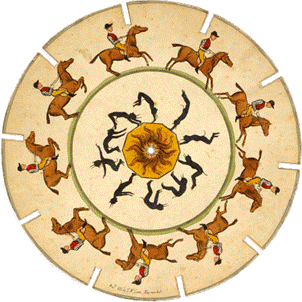The History of Video Production
Ever wondered how the creation of digital video production came about? Videos are a part of our everyday lives; they add vibrant colours and give life to the modern technological innovations we use. The art of cinematography has always been changing from the earliest video recording to Facebook, TikTok videos and upscale Hollywood film and TV shows today. These on-screen images emotionally connect with the audience, especially when there is a human element. Motion graphic films and live-action videos have won over viewers hearts and cemented themselves in our culture.
Joseph Niepce first black-and-white photograph, taken in 1826, is credited with starting the video production genre.
A few years later in 1832, a Belgian physicist Joseph Plateau invented the phenakistoscope, sometimes known as the ‘’spindle viewer’’ which allowed him to imitate moving images for the first time.

(The Phenakistoscope - copyright free: courtesy Public Domain Review)
The Phenakistoscope had two circular revolving discs. The front disc had several phases of a moving object drawn or painted on it. Behind this disc was a larger disc with radial slots in it corresponding with the drawings on the front disc. The Phenakistoscope was held before a mirror and the discs rotated, the observer watching the reflected images of the front disc thru the slots of the back one would see the illusion of movement

(Thomas Edison - copyright free: public domain)
Thomas Edison pioneered real motion picture camaras in 1891. The projector wat first made accessible in 1895. In 1902, at the start of the 19th century, brief scenes in motion pictures began to use colour. Then, in 1918, full-colour films started to appear with the publication of “cupid angling”. Be aware that there is no audio on them.

(The Kinetoscope - copyright free: public domain)
The first movie projector was the Zoopraxiscope, invented by British photographer Eadweard Muybridge in 1879. Operating with rotating glass discs, the zoopraxiscope projected images onto each other in rapid succession, creating the illusion of movement.

(courtesy: Institut Lumière - cinematographe Camera)
This picture is licensed under the Creative Commons Attribution-Share Alike 4.0 International license. You are free to share, to copy, distribute and transmit the work
Two decades later in 1895 and inspired by a Kinetoscope exhibition in Paris, the Frenchmen Auguste and Louis Lumière, would invent their own motion-picture projector, the cinematograph.
In 1902, at the start of the 20th century, brief scenes in motion pictures began to use colour. The first film to be produced in natural colour is ‘A Visit to the Seaside’, a short which used the Kinemacolor process with red and green alternating filters. The first full-length feature film in colour is ‘The World, The Flesh and the Devil’, also using the Kinemacolor process. The Natural Colour Kinematograph Company was a British company formed by Charles Urban in 1909. It sold licences and produced films in Kinemacolor, the first successful colour motion picture process.

(Kinemacolor 35mm projector, 1910
Courtesy: The Kodak Collection at the National Media Museum, Bradford, Science Museum Group Collection)
This picture is licensed under the Creative Commons Attribution-Share Alike 4.0 International license. You are free to share, to copy, distribute and transmit the work
The possibilities for creating videos are always growing. The huge, unwieldy cameras of the past have given way to sleek, smart devices that capture situations with amazing clarity. Drones, those eagles of the modern era, elevate story telling by including breath-taking perspectives.
Almost everyone today has a 4k camera in their pocket allowing for amazing shots in mere seconds. These smartphones come equipped with high resolution camaras that can capture stunning photos with the convenience and portability of a smartphone, people can easily document their lives.
Even though people have such sophisticated equipment doesn’t mean they know how to use it as it takes incredible skill and long periods of time to create a good-looking video production. People can work all their live and not create a blockbuster; it’s all about having the skills and being able to create something never seen before.









